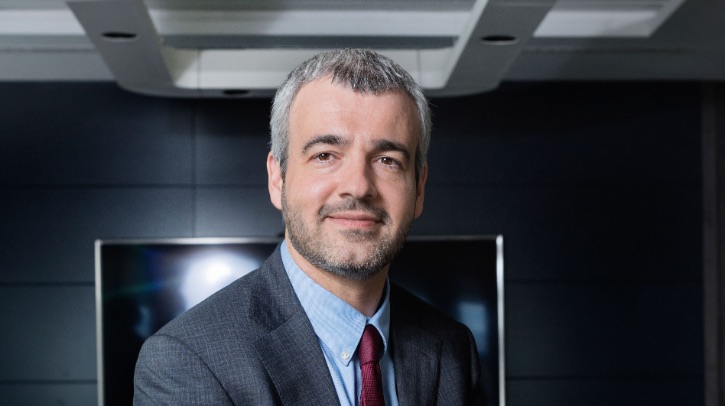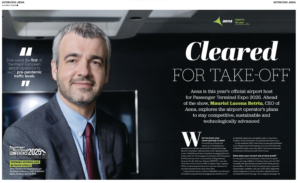Aena is this year’s official airport host for Passenger Terminal Expo 2025. Ahead of the show, Maurici Lucena Betriu, CEO of Aena, explores the airport operator’s plans to stay competitive, sustainable and technologically advanced.
What has been your career journey to date?
I started my professional career as a consultant at a specialized economic analysis firm named Solchaga Recio & Asociados. Subsequently, in the Spanish public sector, I held the positions of general managing director of the Center for Technological and Industrial Development (CDTI) and executive vice president of Engineering Systems for the Defense of Spain (ISDEFE). I was also chairman of the Council of the European Space Agency (ESA), so the aeronautical sector was not unknown to me when I joined Aena a few years later.
In the private sector, at Banco Sabadell, I was director of wealth and prudential management and director of prudential regulation and public policy. I was also a member of the Parliament of Catalonia for three years.
In the academic field, I have been an associate professor in the Department of Economics at Carlos III University of Madrid. Finally, since July 2018, I have been chairman of the board of directors and CEO of Aena.
What does your current role at Aena entail?
For the past six and a half years, I have had the great honor and responsibility of leading Aena, which is 51% owned by the Spanish government and 49% by private shareholders. It is the world’s leading airport operator by passenger numbers, and one of the most important listed companies in terms of market capitalization on the Madrid Stock Exchange. Our company manages 46 airports (plus two heliports) in Spain, our home country, and 33 additional ones in other countries.

Overall, my role can be complex due to the public-private duality of our services. I often need to balance competing priorities, such as shareholder value, stringent regulatory requirements and the company’s duty to the public.
During my time with the organization, Aena has experienced intense activity. After a record-breaking year in 2019 in terms of traffic data and spectacular financial results, we faced two very tough years due to the Covid-19 pandemic, which was not only a global health crisis but also a mobility crisis. We had to adopt immediate and forceful measures overnight to ensure the company’s financial viability while simultaneously maintaining airport operations to provide our public service.
“[We were] the first of the major European airport operators to reach pre-pandemic traffic levels”
We did this successfully. Once normality was restored, we resumed activity with maximum acceleration and without operational disruptions. This made us the first of the major European airport operators to reach pre-pandemic traffic levels.

In recent years, we’ve also made significant acquisitions outside our borders, specifically in Brazil. Between 2020 and 2023, Aena has added a network of 17 Brazilian airports to its management, including Congonhas-São Paulo, the second largest in Brazil, and Recife in the northeast region. As a result, Aena currently manages 20% of air traffic in this large country.
“Aena currently manages 20% of air traffic in [Brazil]”
Can you tell us more about Aena’s recent significant investments and what drove them?
In a large airport infrastructure management company, investment cycles span multiple years. This is certainly the case for Aena, which is also a large airport network. This makes the process even more complex, especially considering the regulations that must be met in the planning, procurement and execution of major infrastructure works.
In our case, thanks to the extraordinary investment process undertaken in previous decades – which comprised more than €15bn [US$15.8bn] between 2001 and 2010 in nominal terms – we have sufficient capacity in our infrastructures to serve around 350 million passengers in the Spanish network.
Despite the fact that Spain has the second-largest number of international tourists in the world according to the World Economic Forum, our airports currently can handle the demand without any problem. However, we are approaching, at least in some of our airports, the capacity limits that our strict quality levels demand. For this reason, we are already working on the first steps to carry out infrastructure expansion projects in the coming years.

What are your main objectives for 2025 and beyond, and what key projects will Aena focus on in the coming year?
Air transportation, and of course Aena, has two major challenges to focus on in 2025 and in the years beyond – sustainability and future capacity.
Sustainability is a global challenge. In Europe, we have taken significant steps to ensure we are clearly committed to decarbonizing our activity. All these individual sustainability actions and strategies must become aligned and should not hinder the development of the infrastructure that is necessary to meet the growing capacity demands.
In this area, Aena’s sustainability strategy includes a significant investment, which is close to €750m [US$780m] in the period 2021-2030. One of its main objectives is to achieve carbon neutrality in 2026 as well as net zero in 2030, 20 years ahead of the overall sector’s goal.
Our Climate Action Plan is structured into three strategic programs: carbon neutrality; sustainable aviation, where we plan to act as a driver for other agents to accelerate their decarbonization; and finally, sustainable community and value chain.
Undoubtedly, innovation will be key to overcoming the sector’s greatest challenge – the fight against climate change. The airports of the future will be designed to promote sustainable mobility for employees and travelers, actively collaborating with the supply chain and the community to drive sustainability. They will also have an energy infrastructure that will facilitate self-sufficiency through renewable energies at airport facilities, including electric charging points to supply new electric vehicles as well as supporting biogas plants.
To achieve global decarbonization, the aviation industry has been working for years on developing new solutions that are technologically feasible, economically viable and reach a sufficient production volume. For example, sustainable aviation fuels (SAF) are a feasible green alternative, although the technology is still in its maturing phase. At our airports, the existing infrastructure is already ready to provide SAF supply to airlines without any negative impact on their day-to-day operations at the airport.

In the medium and long terms, electric batteries and hydrogen will probably be essential in the decarbonization of the sector. Future adoption of hydrogen as fuel will require new refueling infrastructure at airports, and significant coordination among various industry players. For example, at the moment, Aena is conducting pilot tests to accelerate the adaptation of our infrastructure to the use of green hydrogen.
Aena has an unwavering commitment to sustainability, which we integrate into our projects through our previously mentioned Climate Action Plan (CAP). Within the CAP’s electrical energy strategy, the photovoltaic (PV) plan for self-consumption stands out as it involves investments in 10 airports. This strategy also includes introducing LED technology, developing projects for lithium battery and green hydrogen storage and purchasing green energy to cover the total consumption of the airport network.
We plan to deploy geothermal energy in the three main airports of the network to achieve sustainable heating and air-conditioning. There is also a progressive plan to renew equipment (boilers), acquire electric cars and vans, and implement electric charging points to supply them.
“We plan to deploy geothermal energy in the three main airports”
Future capacity is also a key concern. Aena’s traffic forecasts for 2024 estimate a new traffic record, significantly exceeding the 300 million passengers currently hosted by our airports in Spain. These figures and future forecasts underpin the need for a significant investment effort to provide the necessary capacity and implement the associated environmental measures.
Although the majority of Aena’s network infrastructure has sufficient capacity to meet the anticipated needs for the coming years, major hub and tourist airports are currently closer to reaching their capacity and quality limits. To address these future needs, Aena has already begun actively planning the highly demanding schedule of action that needs to be undertaken across our operations.
First, these new needs must be included in our next regulatory period, after an extensive consultation process. Following this, these considerations will lead to a new Airport Regulation Document (DORA) approved by the Spanish government, which will become our framework for action in the period 2027-2031.

Throughout the course of these projects, what challenges have you encountered and how have they been overcome?
Large airport projects require long maturation periods to materialize. It takes a long time to meet the regulatory requirements involved. Planners must also keep unforeseen events in mind, such as a pandemic, as such things can unexpectedly disrupt lives around the world. Additionally, the international environment and the extraordinary dynamism of our society must be considered.
In the face of these uncertainties, Aena follows a rigorous risk analysis process that helps us have high levels of fulfillment in the projects we develop, minimizing delays or cost overruns that would significantly penalize us under our applicable regulatory framework.
The need to reach agreements with a range of different stakeholders (airlines, regional and local administrations, etc.) makes all this a complex process but, at the same time, a very solid one.
How important is growth to Aena and how do you plan to achieve your passenger targets for 2025?
Despite cyclical crises, air transportation has maintained steady growth, remaining resilient to external effects. Before the Covid-19 pandemic, the main agents in the air sector estimated that traffic numbers would double every 15-20 years.
Just as air traffic has grown and evolved exponentially over the past 50 years, Aena’s trajectory and transformation in its management model have been extraordinary and very positive, both quantitatively and qualitatively (successfully facing significant challenges in terms of safety, security, capacity, quality, efficiency and sustainability), adapting to social and technological evolution and being able to take on the challenges presented.
For example, in 1975 passenger traffic in Spain was 37.7 million passengers. This then reached 192.8 million in 2010 and 275.2 million in 2019, making it a record year at that point (average growth of +4.6% per year).
After overcoming the effects of the pandemic, in 2023 we reached a new historic figure with 283.2 million passengers, which we will almost certainly surpass in 2024, significantly exceeding 300 million passengers. This would be in addition to our growing traffic in airports outside Spain, which provides significant strengths and diversification in our activity.
This data forced us to review our strategic plan for 2022-2026 in the first months of 2024, setting new objectives and establishing a more ambitious roadmap.
How does Aena use AI to improve operations?
Aena has its strategic innovation, technology and digitalization plan for 2021-2026 as a fundamental element to achieve its objectives as an organization in an increasingly competitive and demanding environment.
Our vision is to become a benchmark in the use of technology to optimize the customer experience, increase operational efficiency and develop new businesses around sustainable mobility. This plan includes the automation and digitalization of processes focused on the passenger experience and sustainability in various areas: commercial, sustainability, assisted customer, security, integration with the environment and a number of smart service management initiatives for optimized operations.
We also participate, along with other major airports worldwide, in the Airports for Innovation network, which was founded in 2021 by Aena and Aeroporti di Roma. This network helps us seek and identify innovative and sustainable solutions for the global airport sector.
AI will probably revolutionize the airport industry, offering significant benefits for external users and internal management. It is a key technology and will become even more so, for improving airport efficiency, customer experience and sustainability.
Aena has begun testing and adopting AI for various use cases at airports. Some examples include a chatbot we call Oli, to answer customer questions; video analysis in terminals and platforms to monitor handling activity; queue monitoring in the terminal building, monitoring crowding, waiting times and access vehicles; and various systems to make airport climate control more efficient.
The results of all these pilot tests are being analyzed in detail and will help us define an internal AI use strategy that we can deploy, if beneficial, for Aena.
Is there anything else that you would like to add?
The global economy, our societies and, consequently, aviation will have to face numerous uncertainties in the coming years, which could significantly affect us.
The evolution of air traffic can be affected by multiple factors, such as the macroeconomic environment, the global geopolitical situation, social factors, consumption habits, new technologies, natural phenomena and health emergencies. In addition to the existing regulatory measures linked to the fight against climate change, there are uncertainties associated with new potential regulatory restrictions that may lead to changes in fuel prices, new taxes, operational or capacity limitations, etc.
In conclusion, our challenges for the coming years may be scary but our sector is prepared to take them on. We have a historically successful track record in managing crises of various kinds and have been able to overcome them relatively quickly. We will do so again.
This article originally appeared in the January 2025 issue of Passenger Terminal World. To view the magazine in full, click here.


